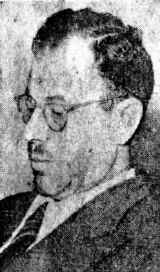Marvin Opler facts for kids
Marvin Kaufmann Opler (born June 13, 1914, died January 3, 1981) was an American anthropologist and social psychiatrist. An anthropologist studies human societies and cultures. A social psychiatrist looks at how society and culture affect mental health.
Marvin's brother, Morris Edward Opler, was also an anthropologist. He studied the Southern Athabaskan peoples of North America. Marvin Opler is most famous for his work on the Midtown Community Mental Health Research Study in New York. This important study showed that city life could cause a lot of stress. It also helped develop the new field of social psychiatry in the 1950s.
Contents
About Marvin Opler
His Education and Early Studies
Marvin Opler went to the University at Buffalo from 1931 to 1934. He was a student leader there. He then moved to the University of Michigan because he admired anthropologist Leslie White. Marvin was interested in how psychology (the study of the mind) and anthropology were connected.
He earned his first degree in social studies from the University of Michigan in 1935. After that, he studied anthropology at Columbia University. There, he learned from famous anthropologists like Ruth Benedict and Ralph Linton.
While studying, Opler did early fieldwork with the Southern Ute people. He also studied the Paiute peoples in Colorado and Utah. He earned his Ph.D. from Columbia in 1938.
Studying Different Cultures
In his work with the Ute and Paiute peoples, Marvin Opler noticed something interesting. Their shamans (spiritual healers) used dream analysis techniques. These were similar to Western psychoanalysis, even though they developed on their own.
He also did fieldwork with Eastern Apache tribes, the Eskimo, and Native American groups on the Northwest Coast in Oregon. From 1938 to 1943, Opler taught sociology and anthropology at Reed College. In 1943, he joined the War Labor Board.
Helping Japanese Americans During WWII
From 1943 to 1946, Opler worked at the Tule Lake War Relocation Center. This was a camp where Japanese Americans were held during World War II. Opler disagreed with this internment. He later helped write a book called Impounded Peoples in 1946 about it.
At Tule Lake, he carefully recorded daily life in the camp. He wrote about unfair treatment and worked with lawyer Wayne M. Collins to help the people held there. His notes included details about "The November Incident." This was a protest by the camp residents that led to the US Army taking over Tule Lake.
Author Barney Shallit described Marvin Opler at Tule Lake. He said Opler, with his red beard and slow movements, looked like "a kind, giant panda." Marvin's wife, Charlotte Opler, even enrolled their son Ricky in the camp's Japanese nursery. He was the only white child there.
Opler noticed that traditional Japanese culture became stronger among the Japanese Americans at Tule Lake. Many of them had already adopted American ways. He saw this as similar to the Ghost Dance religion spreading among Plains Indian tribes in the 1800s. Opler believed both were ways for people who felt controlled to regain their pride.
Historian Peter Suzuki said that many anthropologists working for the government during the war thought the internment was right. But Suzuki felt Marvin Opler's work was a great example of how these anthropologists could have helped. Opler looked at the bigger social and political picture. He criticized separating "loyal" and "disloyal" internees. He also respected Japanese culture. These things made his work stand out.
At Tule Lake, Marvin Opler became friends with several well-known Japanese American internees. One was Yamato Ichihashi, an early Asian American academic. Ichihashi wrote a detailed account of his time in the camp. Opler was also impressed by George T. Tamura, a Japanese American artist. Tamura spent his teenage years imprisoned at Tule Lake. Marvin Opler also wrote an article about Senryū folk poetry with another internee, F. Obayashi. It was published in 1945.
In his book Threatening Anthropology, anthropologist David H. Price mentions FBI documents from 1945. FBI Director J. Edgar Hoover ordered an investigation into Marvin Opler. The FBI wanted to know if Opler was part of the Communist Party. Opler said he had only been a member of the Democratic Party until he moved to Tule Lake. The FBI found that Opler was highly respected by his coworkers and the Japanese Americans in the camp. The FBI described Opler as "cooperative and courteous" and closed the investigation.
After the internment camps closed, Opler taught anthropology and sociology. He taught at colleges like Occidental, Stanford, Harvard, and Tulane from 1946 to 1952. In 1947, Marvin Opler supported three Japanese American citizens. They had given up their citizenship at Tule Lake. He said that they were forced to do so, not that they did it freely. He had seen many of these citizenship hearings at Tule Lake.
Understanding Mental Health in Society
In 1952, Opler joined the Midtown Community Mental Health Research Study in New York. This study showed that many city residents experienced stress and mental health issues. Opler led the part of the study that looked at how culture and society affect mental health. He planned to write a third book for the study, but he passed away before it was finished. His notes for this book are kept at the Columbia Health Science Library Archives.
His work in social psychiatry also showed differences in how schizophrenia appeared in people from different cultures. With Leo Srole, he found that mental health and social mobility (moving up or down in society) were connected. In 1957, Opler helped start the International Journal of Social Psychiatry. In 1958, Opler began working at the State University at Buffalo. He stayed there for the rest of his career. The FBI briefly investigated him again in 1963, but nothing came of it.
In 1964, Opler helped organize the First International Congress of Social Psychiatry in London. That same year, he toured psychiatric hospitals in Moscow with his wife Charlotte and fellow anthropologist Robert F. Spencer. Some scholars, like Richard Drinnon and Peter Suzuki, respected Opler's ideas. Richard Drinnon thought Opler's ideas about cultural revival (when old traditions become strong again) needed more study. One of Opler's popular articles was 'Cross-cultural aspects of kissing' (1969).
His Family
In December 1935, Marvin Opler married Charlotte Fox. She was a student counselor who later worked in biological research, Japanese-American rights, and environmental activism. They divorced in 1970.
Their children are Ruth Opler Perry and Lewis Alan Opler. Ruth Opler Perry is a literature professor at MIT. She studies English literature, women's writing, and feminist theory. Lewis Opler (1948-2018) was a psychiatrist. He helped create the PANSS, a scale used to measure symptoms of psychosis. Several of Marvin Opler's grandchildren are also active in academia. These include Dr. Curtis Perry, Dr. Mark Opler, and Dr. Daniel Opler.
Later Life and Legacy
Marvin Kaufmann Opler died on January 3, 1981. A memorial was held in New York. He was remembered for his academic work and his community involvement. His papers are kept at the Columbia University Health Sciences Library Archives [1].
Other Important Work
Marvin Opler also wrote for many professional journals. He held several important positions:
- Associate editor of the International Journal of Social Psychiatry (1957–58), then editor (1958–81).
- Associate editor of American Anthropologist (1962–65).
- Associate editor of Psychosomatics.
Images for kids
See also
 In Spanish: Marvin Opler para niños
In Spanish: Marvin Opler para niños




